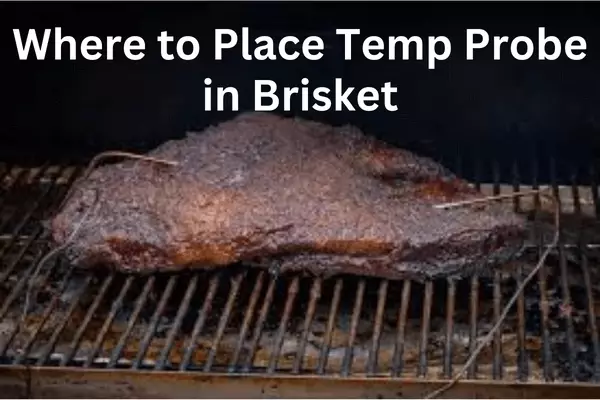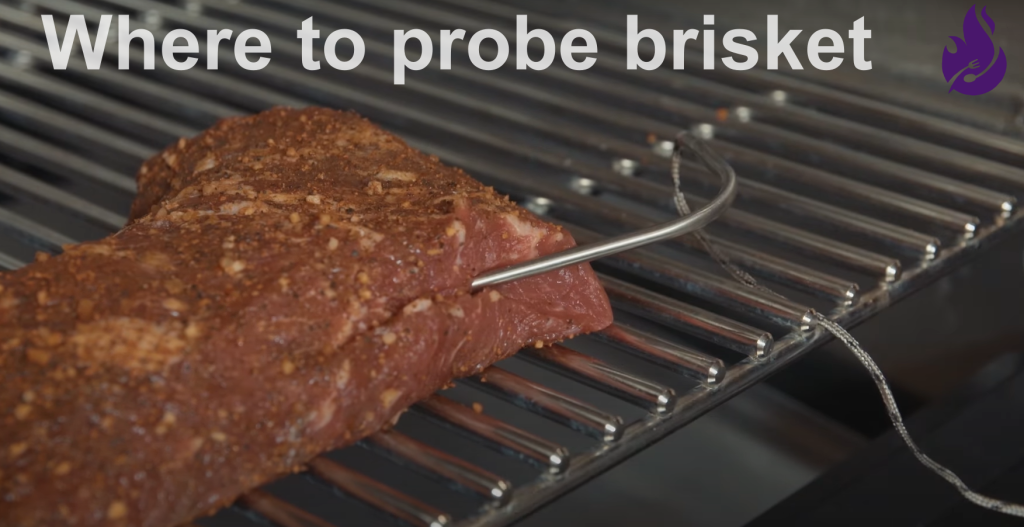Where to Place Temp Probe in Brisket – With Expert Tip
Barbecue enthusiasts have long known that brisket is one of the most delicious cuts of meat and the most difficult to prepare. Brisket requires slow cooking with low temperatures to ensure the meat stays juicy and tender.
You must place your temperature probe in the right spot for accurate readings to get the best results. This blog post will discuss where to put temp probes in brisket to achieve the perfect result. Also Cooking Brisket with the best Offset Smokers using wood chips can add a delicious smoky flavor to the Brisket

Let’s get started to know where to place the temp probe in the brisket.
Additional Resources:
Visit our post on the “Best Offset Smoker under $1000” for additional details on how to select the best offset smoker for your requirements. It offers insightful commentary and suggestions to support your decision-making. We Also reviewed budget-friendly Offset smokers under 500. Have a read and go for the Best option that fulfills your needs and requirements.
Where to Probe Brisket?
For a juicy perfectly cooked brisket, the most important factor is to maintain a consistent temperature throughout the cooking process. To do this, you must probe your brisket to ensure it reaches the correct internal temperature. There are a few different places you can probe your brisket, depending on your desired level of doneness.
I prefer to check the thickest part of the flat which is not always the center of the brisket. Therefore while Inspecting step back a bit and take a distant look at it as a result it will be easier to recognize the thickest area.
The first place to probe your brisket is the flat cut. This cut is the leanest part of the brisket and should be probed in the thickest part of the meat. Check the internal temperature at both ends, as this will give you an accurate reading. Aim for an internal temperature of 155-165 degrees Fahrenheit.

Next, probe your brisket in the point. This is the fattier part of the flat, requiring more heat to reach the desired level of doneness. The internal temperature should reach 165-175 degrees Fahrenheit. Check both ends of the point to get an accurate reading.
Finally, check the point of the brisket. This is the endpoint of the stall, and it should reach an internal temperature of 175-185 degrees Fahrenheit. Check the temperature at both ends for the most accurate reading.
Where to Place Temp Probe in Brisket?
Cooking a brisket is an art form, and one of the most important elements of this delicious cut of meat is temperature control. Knowing the exact temperature of the meat is essential for a moist, tender, and flavorful finished product. You need to know where to place your temp probe in brisket to get the best results.
The thickest part of the flat cut is the best place to insert a thermometer probe into a brisket as shown in the picture above. This part of the brisket usually has the most fat and marbling, which will help it retain its moisture and prevent it from drying out. The flat is also much thinner than the point, so the probe should be inserted deeply into the meat to get an accurate reading.
When inserting the thermometer probe into the brisket, angle it away from the fat cap. This will help avoid false readings from fat. Once the probe is inserted, mark the spot with a piece of kitchen string so you can easily find it again when you need to check the temperature.
Once the thermometer probe is in place, the next step is to set the desired temperature. For the best results, most chefs recommend cooking brisket to an internal temperature of 203F. To ensure the brisket is cooked evenly. You should check the temperature of the meat every 30 minutes or so.
Important Tip
The key factor to consider is the desired level of doneness. Regarding brisket, the goal temperature should be at least 195°F. However, it is essential to note that the internal temperature will continue to rise after the brisket is removed from the heat source, so it is best to pull the brisket off the grill or smoker when the thermometer reads about 190°F.
Purpose of Probing
Temp Probing of brisket is a technique used to monitor and adjust the temperature of the meat during the cooking process. This is especially important for large cuts of meat like brisket, which can take several hours to cook.
The purpose of probing brisket is to continuously monitor the temperature of the meat while it is cooking. This helps ensure that the meat is cooked evenly throughout and reaches the desired internal temperature. Temp probing also helps prevent overcooking, leading to dry, tough meat.
When temp probing brisket, it is important to use a digital thermometer to ensure accuracy. The thermometer should be inserted into the thickest part of the meat, usually near the center. As the meat cooks, the thermometer will measure the internal temperature of the meat and will alert you when it has reached the desired temperature
Read our complete recipe for Beef Beacon for the best cooking experience
Frequently Asked Questions
Conclusion
It’s no secret that the perfect brisket requires precise temperature control. But when it comes to where to place the temperature probe in your brisket, there’s no one-size-fits-all answer. The perfect spot for the temp probe can vary depending on your brisket’s cut and size. But generally, it is done close to the center of the thickest part of the brisket. Placing the probe here will give you the most accurate temperature reading of the brisket and help ensure it is cooked to perfection.
